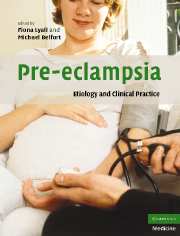Book contents
- Frontmatter
- Contents
- List of contributors
- Preface
- Part I Basic science
- Part II Clinical Practice
- 17 Classification and diagnosis of pre-eclampsia
- 18 Measuring blood pressure in pregnancy and pre-eclampsia
- 19 Immune maladaptation in the etiology of pre-eclampsia; an updated epidemiological perspective
- 20 Genetics of pre-eclampsia and counseling the patient who developed pre-eclampsia
- 21 Thrombophilias and pre-eclampsia
- 22 Medical illness and the risk of pre-eclampsia
- 23 The kidney and pre-eclampsia
- 24 Management of mild pre-eclampsia
- 25 Management of severe pre-eclampsia
- 26 The differential diagnosis of pre-eclampsia and eclampsia
- 27 Complications of pre-eclampsia
- 28 Central nervous system findings in pre-eclampsia and eclampsia
- 29 Pathogenesis and treatment of eclampsia
- 30 Anesthesia for the pre-eclamptic patient
- 31 Critical care management of severe pre-eclampsia
- 32 The role of maternal and fetal Doppler in pre-eclampsia
- 33 Pregnancy-induced hypertension – the effects on the newborn
- 34 Medico-legal implications of the diagnosis of pre-eclampsia
- Subject index
- References
24 - Management of mild pre-eclampsia
from Part II - Clinical Practice
Published online by Cambridge University Press: 03 September 2009
- Frontmatter
- Contents
- List of contributors
- Preface
- Part I Basic science
- Part II Clinical Practice
- 17 Classification and diagnosis of pre-eclampsia
- 18 Measuring blood pressure in pregnancy and pre-eclampsia
- 19 Immune maladaptation in the etiology of pre-eclampsia; an updated epidemiological perspective
- 20 Genetics of pre-eclampsia and counseling the patient who developed pre-eclampsia
- 21 Thrombophilias and pre-eclampsia
- 22 Medical illness and the risk of pre-eclampsia
- 23 The kidney and pre-eclampsia
- 24 Management of mild pre-eclampsia
- 25 Management of severe pre-eclampsia
- 26 The differential diagnosis of pre-eclampsia and eclampsia
- 27 Complications of pre-eclampsia
- 28 Central nervous system findings in pre-eclampsia and eclampsia
- 29 Pathogenesis and treatment of eclampsia
- 30 Anesthesia for the pre-eclamptic patient
- 31 Critical care management of severe pre-eclampsia
- 32 The role of maternal and fetal Doppler in pre-eclampsia
- 33 Pregnancy-induced hypertension – the effects on the newborn
- 34 Medico-legal implications of the diagnosis of pre-eclampsia
- Subject index
- References
Summary
Introduction
The hypertensive disorders of pregnancy affect more than 10% of the antenatal population. Each year they complicate 80,000 pregnancies in the United Kingdom and account for between 12 and 24% of antenatal admissions (Twaddle and Harper, 1992). Frequent outpatient measurement of blood pressure and urinalysis for proteinuria are the basis of routine antenatal care. The purpose of these tests is to screen for the development of pre-eclampsia, which remains one of the largest causes of maternal and perinatal mortality and morbidity (Walker, 2000). In order to make sure that potential at-risk cases are not missed, the thresholds for diagnosis are kept low and there is a high false positive rate. This means that a further assessment system needs to be in place as a further filter. Many women, especially late in the third trimester, develop transient hypertension that is not sustained, and, therefore, does not contribute to adverse perinatal or maternal outcome. This method of stepwise care helps to diagnose those at-risk of severe pre-eclampsia early, allowing management and intervention which has done much to reduce the maternal mortality rate in the last 30 years (Walker, 2000).
Walker (1987) and Walker et al. (1989) in separate studies examined the progression of hypertension in women attending an outpatient Antenatal Day Unit (ADU) setting from 28 weeks of gestation. These women attended because of a diastolic blood pressure (DBP) greater than 90 mmHg recorded at the antenatal clinic.
- Type
- Chapter
- Information
- Pre-eclampsiaEtiology and Clinical Practice, pp. 357 - 368Publisher: Cambridge University PressPrint publication year: 2007
References
- 1
- Cited by



